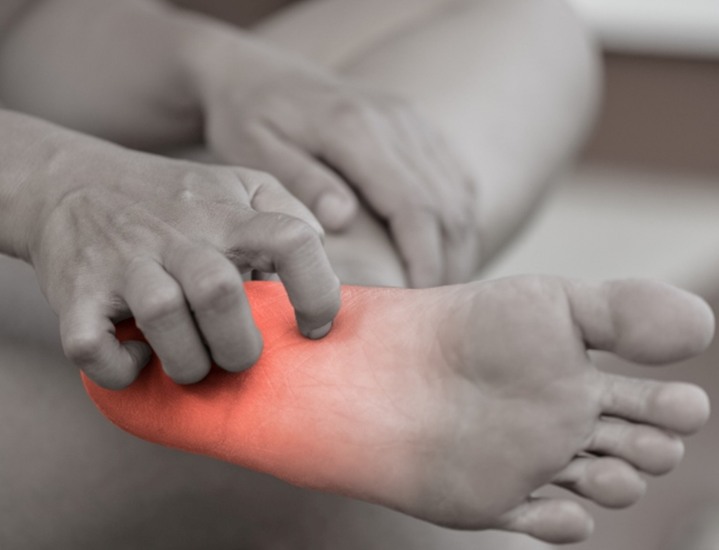15/03/2024 0 Comments
Most Common Types of Heel Pain
Why Does My Heel Hurt?
If you consider all of the stress we put on our heels, it is not really surprising that heel pain is common. In fact, heel pain affects over two million Americans every year. Even if you don’t stand on your feet every day, every mile you walk puts 60 tons of stress on each foot. Repetitive stress takes a toll on the heel, and this can result in pain.

Why You Should Not Ignore Heel Pain
Though heel pain is common, it should not be ignored. Continuing to be active, even when your heel hurts, will only make the pain worse. Too much activity on an already injured heel can lead to a chronic condition. Fortunately, there are treatments available to alleviate heel pain and get you back to doing all the things you want to do.
Symptoms
All heel pain is not the same. The location of pain can vary - It can occur on the back or bottom of the heel. The severity of pain can also vary – dull or sharp. There are conditions that will cause pain behind the heel, and conditions that cause pain in the heel bone itself. Let’s take a look at some of the top heel pain causes, as well as effective heel pain treatment.
7 Most Common Types of Heel Pain
- Plantar Fasciitis is the most common heel issue. This occurs when the muscles and tendons in the arch of the foot become inflamed, causing pain on the bottom of the heel, or in the middle of the foot. The pain can be intense, and is typically worse after a prolonged period of sitting or lying down. This is why many people with plantar fasciitis report pain that is worse in the morning, when they first wake up. Plantar fasciitis primarily affects active adults between 40 and 70, pregnant women, people who are overweight, and those with structural issues like high arches or flat feet. Applying an ice pack, resting the foot, and taking an anti-inflammatory medication can help, but it these methods are not effective, a corticosteroid can be injected directly into the damaged ligament, to provide relief. Stretching exercises and footwear that provides appropriate support can help prevent further episodes of plantar fasciitis.
- Sometimes, the heel bone, or calcaneus, is affected. Heel pain could be caused by bone spurs.. Heel spurs are common, especially among athletes who do a lot of running and jumping, and many people with this kind of bone spur don’t experience pain. However, if you have bone spurs that are painful, anti-inflammatory medication and specialized footwear can help. If this treatment doesn’t help, and the pain is acute, there are surgical procedures available to treat bone spurs.
- Stress fractures are another cause of heel pain. These injuries occur slowly, over time, unlike a broken bone, which is the result of a specific event. Because of this, stress fractures often go undiagnosed as the pain gradually increases, which is frustrating. There is not much that can be done for stress fractures; they’re treated with rest.
- Tarsal tunnel syndrome (TTS) is pain caused by a nerve being compressed. This nerve entrapment can happen all of a sudden or gradually, over a long period of time. TTS is a serious problem, and requires medical attention. It’s typically treated using rest and physical therapy, though your doctor may recommend other treatments, based on your prognosis.
- Achilles tendonitis is a common sporting complaint. This is damage to the tendon that connects calf muscles to the heel bone, and is generally the result of over-stretching, overuse, or an accident. When the Achilles tendon is pushed beyond its normal range, it can develop multiple microscopic tears, causing pain and limited range of motion. There are many non-invasive treatments for Achilles tendonitis, as well as surgical options for extreme cases, so it’s important to see a doctor for this condition.
- Heel bursitis occurs when the bursa, the fluid-filled sac cushioning the heel, becomes inflamed. This inflammation can cause pain that feels like a marble in the heel of your shoe, and is caused by repeated irritation from landing on the heels too hard, or from pressure placed by footwear. The pain can travel up the Achilles tendon, and tends to get worse as the day progresses. Treatments can be similar to plantar fasciitis.
- Sever’s disease is the most common cause of pain in child and adolescent athletes. Typically affecting girls between 8 and 13 years old, and boys from 10 to 15, it’s triggered by microtraumas to the heel plate that happen during a growth spurt. Because the heel bone grows faster than the ligaments in the legs, its easy for the muscles and tendons to become overstretched and tight, leading to heel injury. Icing, physical therapy, and rest are the best treatments for this issue.
If you are experiencing pain in your heel, do not delay in seeking heel pain treatment from an experienced professional. At Southern Delaware Foot and Ankle, our physicians have been trained to provide comprehensive medical and surgical treatment of the foot and ankle, and we have earned a reputation for providing expert quality care. Established in 2000, we are committed to providing the highest quality of care for conditions affecting the lower extremity, in a compassionate, professional environment with a safe and comfortable atmosphere. Schedule an appointment by calling one of our four convenient locations: Seaford Shipley Street, 302-715-4194, Seaford Riverside, 302-629-6162, Millsboro Dupont Hwy, 302-934-7100, or Millsboro John J. Williams Hwy, 302-945-1221. You can also reach out to us through our website with any questions, and let Southern Delaware Foot & Ankle help you put your best foot forward.
Comments